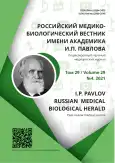脑源性神经营养因子在处理创伤后果的过程中的作用研究
- 作者: Faustova A.G.1, Krasnorutskaya O.N.2
-
隶属关系:
- Ryazan State Medical University
- N.N. Burdenko Voronezh State Medical University
- 期: 卷 29, 编号 4 (2021)
- 页面: 521-530
- 栏目: Original study
- URL: https://journal-vniispk.ru/pavlovj/article/view/83496
- DOI: https://doi.org/10.17816/PAVLOVJ83496
- ID: 83496
如何引用文章
详细
论证:心理创伤会对大脑半球的海马体、杏仁核和前额皮质造成明显的损伤。脑源性神经营养因子(BDNF—brain-derived neurotrophic factor) 在缺血性脑损伤和外伤性脑损伤中具有神经保护作用。到目前为止,还没有足够的理由确认BDNF在克服创伤性事件的负面后果的过程中也确保了神经系统的生存能力。
目的:研究经历过创伤事件并表现出有效应对的个体稳定表型心理表现与血清中BDNF含量的关系。
材料与方法:对33名(女性26名,男性7名,平均年龄为26.3±7.46岁)在过去3年经历过创伤性事件的受访者进行了BDNF水平(使用定量固相酶免疫分析法)、心理稳定性的个人和行为相关因素(使用心理提问的方法)的研究。数学和统计处理的经验数据涉及使用相关分析和多元回归分析。
结果:患者血清中BDNF含量可作为应激抵抗严重程度(t=2.093,p=0.045)、适应不良状态(t=2.511,p=0.018)、创伤后成长(“人格的力量”:t=2.911,p=0.007;“新机会”:t=2.242,p=0.032)和心理健康(t=-3.106,р=0.004)表现的预测因子。
结论:研究的现实意义在于建立临床心理学的证据基础,改进诊断方法,为创伤性事件受害者提供临床和心理援助。
作者简介
Anna Faustova
Ryazan State Medical University
编辑信件的主要联系方式.
Email: lakoniya@yandex.ru
ORCID iD: 0000-0001-8264-3592
SPIN 代码: 5869-7409
Chair of the Department of Clinical Psychology
俄罗斯联邦, RyazanOl'ga Krasnorutskaya
N.N. Burdenko Voronezh State Medical University
Email: lech@vrngmu.ru
ORCID iD: 0000-0001-7923-1845
SPIN 代码: 3953-4656
MD, Dr. Sci. (Med.), Associate Professor
俄罗斯联邦, Voronezh参考
- Koenen KC, Ratanatharathorn A, Ng L, et al. Posttraumatic stress disorder in the World Mental Health Surveys. Psychological Medicine. 2017;47(13):2260–74. doi: 10.1017/S0033291717000708.
- Faustova AG. Genetic markers of psychological resilience and coping behavior. In: Sposobnosti i mental’nyye resursy cheloveka v mire global’nykh peremen. Moscow: Institut psikhologii RAN; 2020. P. 1168–76. (In Russ).
- Faustova AG, Afanas’yeva AE, Vinogradova IS. Psychological resilience and phenomenologically close categories. Personality in a changing world: health, adaptation, development. 2021;9(1):18–27. Available at: http://humjournal.rzgmu.ru/art&id=466. Accessed: 6 Oct 2021. (In Russ). doi: 10.23888/humJ2021118-27
- Logue MW, van Rooij SJH, Dennis EL, et al. Smaller hippocampal volume in posttraumatic stress disorder: a multisite ENIGMA-PGC study: subcortical volumetry results from posttraumatic stress disorder consortia. Biological Psychiatry. 2018;83(3):244–53. doi: 10.1016/j.biopsych.2017.09.006
- McEwen BS, Nasca C, Gray JD, et al. Stress effects on neuronal structure: hippocampus, amygdala, and prefrontal cortex. Neuropsychopharmacology. 2016;41(1):3–23. doi: 10.1038/npp.2015.171
- O'Doherty DCM, Chitty KM, Saddiqui S, et al. A systematic review and meta-analysis of magnetic resonance imaging measurement of structural volumes in posttraumatic stress disorder. Psychiatry Research. 2015;232(1):1–33. doi: 10.1016/j.pscychresns.2015.01.002
- Kolov SA, Sheichenko EYu. The role of hypothalamic-pituitary-adrenal axis dysfunction in psychopathology of war veterans. Sotsial’naya i Klinicheskaya Psikhiatriya. 2009;19(3):74–9. (In Russ).
- Frank MG, Watkins LR, Maier SF. Stress-induced glucocorticoids as a neuroendocrine alarm signal of danger. Brain, Behavior and Immunity. 2013;33:1–6. doi: 10.1016/j.bbi.2013.02.004
- Ousdal OT, Milde AM, Hafstad GS, et al. The association of PTSD symptom severity with amygdala nuclei volumes in traumatized youths. Translational Psychiatry. 2020;10(1):1–10. doi: 10.1038/s41398-020-00974-4
- Morey RA, Haswell CC, Hooper SR, et al. Amygdala, hippocampus, and ventral medial prefrontal cortex volumes differ in maltreated youth with and without chronic posttraumatic stress disorder. Neuropsychopharmacology. 2016;41(3):791–801. doi: 10.1038/npp.2015.205
- Liu H, Zhang C, Ji Y, et al. Biological and psychological perspectives of resilience: is it possible to improve stress resistance? Frontiers in Human Neuroscience. 2018;12:326. doi: 10.3389/fnhum.2018.00326
- Miranda M, Morici JF, Zanoni MB, et al. Brain-Derived Neurotrophic Factor: A Key Molecule for Memory in the Healthy and the Pathological Brain. Frontiers in Cellular Neuroscience. 2019;13:363. doi: 10.3389/fncel.2019.00363
- Ostrova IV, Golubeva NV, Kuzovlev AN, et al. Prognostic Value and Therapeutic Potential of Brain-Derived Neurotrophic Factor (BDNF) in Brain Injuries (Review). General Reanimatology. 2019;15(1):70–86. (In Russ). doi: 10.15360/1813-9779-2019-1-70-86
- Zhivolupov SA, Samartsev IN, Marchenko АА, et al. The prognostic significance of brain-derived neurotrophic factor (BDNF) for phobic anxiety disorders, vegetative and cognitive impairments during conservative treatment including adaptol of some functional and organic diseases of nervous system. Zhurnal Nevrologii i Psikhiatrii imeni S.S. Korsakova. 2012;112(4):37–41. (In Russ).
- Karakulova IuV, Selianina NV. Monitoring of neurotrophic factors and cognitive function in patients with traumatic brain injury. Zhurnal Nevrologii i Psikhiatrii imeni S.S. Korsakova. 2017;117(10):34–7. (In Russ). doi: 10.17116/jnevro201711710134-37
- Selyanina NV, Karakulova YuV. Influence of cerebral neurotrophic factor on rehabilitational potential after cerebrocranial traumata. Medical Almanac. 2017;(5):76–9. (In Russ).
- Notaras M, van den Buuse M. Neurobiology of BDNF in fear memory, sensitivity to stress, and stress-related disorders. Molecular Psychiatry. 2020;25(10):2251–74. doi: 10.1038/s41380-019-0639-2
- Felmingham KL, Zuj DV, Hsu KCM, et al. The BDNF Val66Met polymorphism moderates the relationship between Posttraumatic Stress Disorder and fear extinction learning. Psychoneuroendocrinology. 2018;91:142–8. doi: 10.1016/j.psyneuen.2018.03.002
- Osório C, Probert T, Jones E, et al. Adapting to stress: understanding the neurobiology of resilience. Behavioral Medicine. 2017;43(4):307–22. doi: 10.1080/08964289.2016.1170661
- Mojtabavi H, Saghazadeh A, van den Heuvel L, et al. Peripheral blood levels of brain-derived neurotrophic factor in patients with post-traumatic stress disorder (PTSD): A systematic review and meta-analysis. PLoS One. 2020;15(11):e0241928. doi: 10.1371/journal.pone.0241928
补充文件






